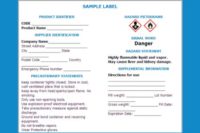TRAINING STRATEGIES: Avoid hazcom labeling headaches

For more than 25 years, OSHA’s hazard communication standard (HCS) has sought to ensure that the hazards — as well as the necessary protective measures — of all chemicals produced or imported are evaluated and that the information concerning these hazards is transmitted to employers, and to employees in hazcom training classes.
The three core elements of the standard include:
- Labeling
- MSDS (Material Safety Data Sheets) authoring, distribution, and management
- Employee training
Are all hazards on the label?
It’s often difficult to be fully compliant with OSHA guidelines when training employees about the labeling of health and physical hazards as well as target organ effects of chemicals on workplace labels. Target organ effects indicate which bodily organs are most likely to be affected by exposure to a substance. While target organ effects and health and physical hazards information may be well-documented on the MSDS, they often do not make it to the workplace label.
According to OSHA’s own guidance, “the requirements are performance-oriented, so employers may choose how to convey the hazard information on the label. Many follow the suggestions of the ANSI labeling standard in terms of language used to convey the hazards, but others do not. As a result, (when training your workers they can be confused to see) different statements that convey the same information from different suppliers.” (OSHA1)
Employers often lack a formal chemical labeling system or employ a separate, third-party labeling system disconnected from the overall MSDS and chemical data management program. This presents a situation where critical health and physical hazard information might not be properly transmitted to the workplace label, resulting in training hassles and worse, possible injury, illness or compliance issues.
While the MSDS provides the foundational data for effective workplace labeling and employee training, the hazcom standard designates a different purpose for the data found on a workplace label. Specifically, “the label is intended to be an immediate visual reminder of the hazards of a chemical. When evaluating which hazards should be included, the manufacturer, importers, and distributors must assess the evidence regarding the product’s hazards and must consider exposures under normal conditions of use or in foreseeable emergencies when evaluating what hazards shall be put on the label. This is not to say that only acute hazards are to be listed on the label, or that well-substantiated hazards should be left off the label because they appear on the MSDS.” (OSHA2)
You can see how reviewing the labeling part of your hazcom efforts during employee training can be problematic.
A compliant label
According to the standard, a compliant workplace label must include three fundamental elements:
- Identity of the hazardous chemical(s)
- Appropriate hazard warnings
- Name and address of the chemical manufacturer, importer, or other responsible party
The key phrase in this definition is “other appropriate form of warning.” These definitional ambiguities as well as OSHA’s ultimate focus on health safety performance rather than strict implementation guidance allows for multiple methods of compliance. Consequently, the type of labeling approach you take may have a direct impact on your employee training.
Manually-written vs. alternative labeling
The approaches employers take range from manually- written hazard warnings on labels to in-plant labeling systems to integrated MSDS management and chemical labeling systems. The risks of a manual label system are obvious with respect to capturing and communicating hazard warnings and target organ effects. However, the use of alternative labeling systems such as the HMIS (Hazardous Material Information System), NFPA (National Fire Protection Association), and others requires additional discipline in the inter-related elements of MSDS documentation and employee training.
According to OSHA Directive CPL 02-02-038, “employers using alternative labeling systems must ensure that their employees are aware of all information required to be conveyed under the HCS. OSHA will make a plant-specific determination of the effectiveness of the complete program when an inspection is conducted. Any employer who relies on one of these types of alternative labeling systems instead of using labels containing complete health effects information will — in any enforcement action alleging the inadequacy of the labeling system — bear the burden of establishing that it has achieved a level of employee awareness which equals or exceeds that which would have been achieved if the employer had used labels containing complete health effects information.” (OSHA3)
An integrated approach
Alternatively, a centralized approach taken by most leading EHS professionals is to produce workplace labels directly from the MSDS and chemical data management system. Having an electronic database of chemical data indexed with the health and physical hazards as well as the target organ effects removes the ambiguity of the standard, lowers the risk of compliance citations and ensures that hazard warning and target organ effects are clearly communicated to the at-risk population.
This integrated approach takes advantage of the interdependencies discussed earlier among the MSDS document, the chemical label, and employee training. When employees understand chemical hazards by understanding the terms, the effects and all other information found on the labels, they will be safer and you will have a HAZCOM program that is right on target.
Footnotes
1 OSHA (2004), “Hazard Communication in the 21st Century”.
2 OSHA, CPL 02-02-038 - Inspection Procedures for the Hazard Communication Standard.
3 OSHA, CPL 02-02-038 - Inspection Procedures for the Hazard Communication Standard.
Looking for a reprint of this article?
From high-res PDFs to custom plaques, order your copy today!






